
New Delhi: Mumbai woke up to a smoggy morning on Sunday, with thick smog engulfing the city and reducing visibility significantly. As of 9 am, SAFAR-India recorded an Air Quality Index (AQI) of 179, placing the city in the ‘moderate’ zone.
While most people don’t typically worry about this level of pollution, people with respiratory conditions, including asthma and heart disease, may experience breathing discomfort.
AQI performance varies across the city, and pollution levels are significantly higher in some areas. For example, areas like Fire Station Malad (276) and BMC Shastri Garden Worli (250) have AQI in the ‘poor’ category, while areas like Chembur (55) are relatively clean.
The heavy fog reduced visibility to less than 500 meters in some areas, and high-rise buildings appeared very hidden in the fog.
Despite the poor air quality, many Mumbaikars continued with their morning routines, spotting joggers and walkers on the Marine Drive through thick fog.
At the same time, the air quality situation in Delhi has become more severe. As of 8:00 a.m., the capital’s AQI soared to 428, firmly ranking in the “severe” category. The toxic smog, caused by a combination of local pollution and stubble burning by neighboring countries, leaves residents struggling with poor visibility and increases health risks. The capital has struggled with high pollution levels in recent weeks, with air quality in the “severe” range and public health concerns continuing to grow.
As Delhi grapples with deteriorating air quality, residents are sounding the alarm over the dangerous effects of ongoing pollution. The city’s authorities are under increasing pressure to take measures to deal with the current crisis.







